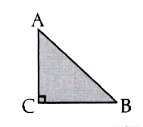ABC is an isosceles triangle right angled at B. Similar triangles ACD and ABE are constructed on sides AC and AB. The ratio between the areas of is
The correct Answer is:B
To find the ratio between the areas of triangles ABE and ACD, we can follow these steps:
Step 1: Understand the Properties of Triangle ABC
Given that triangle ABC is an isosceles triangle right-angled at B, we know that:
- AB = BC (since it's isosceles)
- The angle at B is 90 degrees.
Step 2: Use the Pythagorean Theorem
In triangle ABC, we can apply the Pythagorean theorem:
AC2=AB2+BC2
Since AB = BC, we can substitute:
AC2=AB2+AB2=2AB2
Thus, we have:
AC2=2AB2
This will be useful later.
Step 3: Area of Similar Triangles
The areas of similar triangles are proportional to the squares of their corresponding sides. Therefore, we can express the ratio of the areas of triangles ABE and ACD as:
Area of △ABEArea of △ACD=(ABAC)2
Step 4: Substitute the Values
From our previous step, we know:
AC2=2AB2
So, we can find the ratio:
ABAC=AB√2AB2=ABAB√2=1√2
Step 5: Calculate the Ratio of Areas
Now, substituting this into our area ratio:
Area of △ABEArea of △ACD=(1√2)2=12
Final Answer
Thus, the ratio of the areas of triangles ABE and ACD is:
Area of △ABEArea of △ACD=12
---
Given that triangle ABC is an isosceles triangle right-angled at B, we know that:
- AB = BC (since it's isosceles)
- The angle at B is 90 degrees.
In triangle ABC, we can apply the Pythagorean theorem:
AC2=AB2+BC2
Since AB = BC, we can substitute:
AC2=AB2+AB2=2AB2
Thus, we have:
AC2=2AB2
This will be useful later.
The areas of similar triangles are proportional to the squares of their corresponding sides. Therefore, we can express the ratio of the areas of triangles ABE and ACD as:
Area of △ABEArea of △ACD=(ABAC)2
From our previous step, we know:
AC2=2AB2
So, we can find the ratio:
ABAC=AB√2AB2=ABAB√2=1√2
Now, substituting this into our area ratio:
Area of △ABEArea of △ACD=(1√2)2=12
Thus, the ratio of the areas of triangles ABE and ACD is:
Area of △ABEArea of △ACD=12
Topper's Solved these Questions
- CIRCLES Book:S CHAND IIT JEE FOUNDATIONChapter:CIRCLES Exercise:SELF ASSESSMENT SHEET - 24
Explore 10 Videos
- AVERAGEBook:S CHAND IIT JEE FOUNDATIONChapter:AVERAGEExercise:SELF ASSESSMENT SHEET
Explore 10 Videos
- CO-ORDINATE GEOMETRYBook:S CHAND IIT JEE FOUNDATIONChapter:CO-ORDINATE GEOMETRYExercise:Self Assessment Sheet
Explore 10 Videos
Similar Questions
ABC is an isosceles triangle, right-angled at B. Similar trianles ACD and ABE are constructed on sides AC and AB. Find ratio between the areas of ΔABEandΔACD.
View SolutionABC is an isosceles triangle right-angled at B. Similar triangles ACD and ABE are constructed on side AC and AB. Find the ratio between the areas of triangle ABE and triangle ACD.
View Solution
Knowledge Check
ABC is an isosceles right angled triangle with ∠B=90∘. On the sides AC and AB, two equilateral triangles ACD and ABE have been constructed. The ratio of area of ΔABE and ΔACD is
A1:3B2:3C1:2D1:√2ABC is an isosceles triangle, which is right angled at B with AB = 4 cm. What is the length of AC?
A2 cmB2√2 cmC4 cmD4√2 cmABC is an isosceles triangle, which is right angled at B with AB = 4 cm. What is the length of AC?
A2 cmB2√2cmC4 cmD4√2 cm
ABC is an isosceles triangle right-angled at C. Prove that AB2=2AC2.
View SolutionABC is an isosceles right triangle right-angled at C . Prove that AB2=2AC2 .
View SolutionIn ΔABC,DandE are the midpoint of AB and AC respectively. Find the ratio of the areas of ΔADEandΔABC.

View SolutionABC is an isosceles right triangle, right-angled at C . Prove that: AB2=2AC2.
View SolutionIn Figure ABC is an isosceles triangle right angled at C with AC = 4 cm . Find the length of AB .

View Solution
